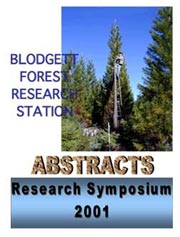ABSTRACT 21
The Biochemistry and Molecular Biology of Aggregation Pheromone Production in the California Fivespined Ips, Ips paraconfusus
Steve Seybold
Department of Entomology and Forest Resources, 219 Hodson Hall, 1980 Folwell Avenue, University of Minnesota, St. Paul, MN 55108-6125, (612) 624-3715, sseybold@tc.umn.edu
|
|
|
Since 1993 my research associates and I have conducted basic research on the regulation and production of pheromones in several bark beetle species. One of the key species in these studies has been the California fivespined ips, Ips paraconfusus Lanier. Our research on this species has been done with insects collected exclusively from Blodgett Research Forest in ponderosa pine, Pinus ponderosa, and this practice has maintained the fidelity set by the original pheromone isolation from this insect by D.L. Wood and colleagues in the 1960’s.
Using radiolabeling techniques we have shown that this species can synthesize its pheromone components ipsenol and ipsdienol de novo from acetate or mevalonate, suggesting that bark beetles can produce their pheromones with some measure of independence from their host pines [Seybold, S.J. et al. 1995. Proc. Nat. Acad. Sci. USA 92:8393-8397.]. From this species we have also isolated the first gene from a bark beetle and demonstrated that this gene [which codes for the enzyme 3-hydroxy-3-methylglutaryl-CoA reductase (HMG-R)] is involved in pheromone biosynthesis and is under the control of an insect hormone called juvenile hormone [Tittiger, C., et al. 1999. Cell. Molec. Life Sci. 55:121-127.]. Most recently we have found that I. paraconfusus and the related species I. pini may regulate pheromone biosynthesis differently and that I. paraconfusus may have an additional hormone necessary to turn on pheromone production. This research is leading to the discovery of unique and specific biochemical targets for the management of bark beetles and to the discovery of enzymes that might be used in industrial processes to synthesize highly pure pheromones for use in monitoring or mass trapping programs. These studies have been supported by extramural funding from the USDA NRI-CGP, from the NSF, from the USDA Forest Service, and recently from the University of Minnesota Graduate School. The technical support provided by the Blodgett Research Forest Staff is also acknowledged and greatly appreciated.
|

